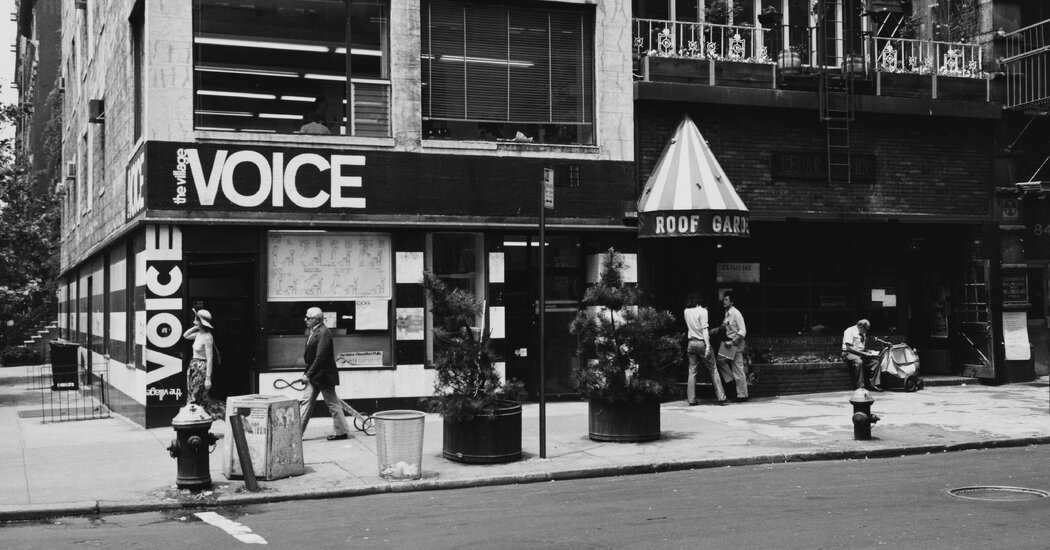THE FREAKS CAME OUT TO WRITE: The Definitive History of The Village Voice, the Radical Paper That Changed American Culture, by Tricia Romano
Tricia Romano’s oral history of The Village Voice, the most important alternative weekly of the 20th century, is a well-made disco ball of a book — it’s big, discursive, ardent, intellectual and flecked with gossip. “The Freaks Came Out to Write” may be the best history of a journalistic enterprise I’ve ever read, in that its garrulous tone so mirrors the institution’s own.
A lot of the people Romano interviewed, former Voice writers, editors, photographers, designers and cartoonists, will probably wince, at times, at the text. Humiliations are recalled; toes are trod upon; old hostilities have been kept warm, as if on little Sterno cans of pique. Nostalgia remains at arm’s length. Yet the tone is familial and warm. Discontent was part of The Voice’s DNA. For nearly every staffer, working there was the best thing they ever did.
Founded in 1955 by a group of writers and editors that included Norman Mailer, The Voice was intended to be a newspaper for downtown, defined as below 14th Street in Manhattan. Its influence grew to be national. The Voice’s heroic period ran from the late 1960s through the early 1990s, though there were slack stretches in between. The publication still exists in a desiccated and mostly online form, in the same way that Sports Illustrated is existing until someone has the decency to unscrew the final lightbulb.
For many oddballs and lefties and malcontents out in America’s hinterlands (I was among them), finding their first copy of The Voice was more than eye-opening. Here was a dispatch from another, better planet. There was nothing else like it. It drove many to go into journalism, or to move to New York, or both. Others fed their heads as long-distance subscribers. You could count on each issue to have been scuffed up by the vicissitudes of the U.S. Postal Service. Some of the scuffing may have been half-intentional. As one art director puts it, the covers tended to look like “The New York Post on acid and run by communists.”
Like many publications, The Voice was divided into two halves. The front of the book was for hard news, and in back resided social commentary and criticism. Even further back were The Voice’s renowned classified ads. For decades people would line up on the night before publication, in the pre-internet days, to get first crack at the apartment listings. People found their whole lives back there. It was a counterculture bulletin board. Blondie got its drummer by advertising there; so did Springsteen. The sex ads were r-a-u-n-c-h-y.
You can approach this book as urban history. Romano has chopped it into brisk set pieces — how The Voice covered Robert Moses’s plan to run a speedway though downtown, the Stonewall riots, the early years of Rudy Giuliani and Donald J. Trump, the Central Park Five and so on. The Voice played rough. Annual features included “10 Worst Judges” and “10 Worst Landlords,” as reported by the muckraker Jack Newfield. Imagine the impact such lists would have today. Imagine the impact then.
The back of the book slowly swamped the front. The Voice gave America most of the first important rock and then hip-hop criticism. It was the first paper to pay close attention to Off Broadway, and it started the Obie Awards. The literate satire of Jules Feiffer’s cartoons defined a generation’s sensibility and won a Pulitzer Prize. The Voice covered the nascent downtown art and film scenes in a way no one had.
Its critics were mighty, a killer’s row, and they often wrote in the first person, a rare thing at the time. In music, there were, to name but a few, Robert Christgau, Ellen Willis, Nelson George, Lester Bangs, Stanley Crouch, Greg Tate, Greil Marcus and James Wolcott. In art, Peter Schjeldahl, Roberta Smith and Gary Indiana. In movies, Jonas Mekas and Andrew Sarris. The novelist Colson Whitehead worked for the literary section and wrote television reviews. His editor initially worried he was too straight for The Voice because he wore a tie.
Perhaps more important was the paper’s commentary on feminism and gay rights. Vivian Gornick wrote important essays, as did Susan Brownmiller (one of her earliest was called “On Goosing”). Karen Durbin wrote a piece about the sympathy she felt for the Glenn Close character in “Fatal Attraction.” During the AIDS crisis, The Voice printed a condom on its cover. There was a sense of sustained outrage. Nat Hentoff rumbled almost weekly, in his columns, about the First Amendment, before infuriating everyone by coming out against abortion. The Voice’s sports section sent Ishmael Reed to report on the 1978 Muhammad Ali versus Leon Spinks fight, and the resulting piece ran on the cover. Its food writers, including Robert Sietsema, scanned the outer boroughs and were not interested in the top 10 gelato parlors.
The Voice defined itself against the vastly stuffier New York Times. The Times was, Whitehead says, “the Man.” To moments of glory in this book, variations of one taunt are consistently appended: “You wouldn’t read that in The New York Times.” The Voice wobbled consistently on the edges of libel; it welcomed all varieties of life; it got more of what made us human into its pages. Voice writers let their messy lives hang out.
Owners and top editors came and went. The former included Rupert Murdoch, who called the paper “the bane of my existence.” So did writers. Christgau — his potent editing skills are analyzed and praised — liked to say that 50 percent of the paper was good and 50 percent awful, though no one could agree on which 50 percent.
Romano, who worked at The Voice for eight years in its later stages, clearly asked good questions, and she has a snappy sense of conversational rhythm. Like a capable film director, she knows how to enter a scene late and leave it early. You always want a bit more of whatever topic she is allowing people to explore.
Out of context and unattributed, here are a few lines from this gaggle of talking heads: “Meeting deadlines, you know, interfered with taking drugs”; “I’m sure that every major person at The Voice had an F.B.I. file”; “We had at least three writers who wouldn’t use punctuation”; “Is Jack dead? Good”; “Lou Reed knocked up a friend of mine, and we had to help her get rid of the fetus”; “He hit Ron Plotkin, too”; “What do you think we are? A whorehouse on a field trip?” A lot of the punches came from Crouch, who believed that the pen was mightier than the sword but did not always have a pen at hand.
One contributor comments that while in certain newspapers the second mention of Derek Jeter would be “Mr. Jeter,” in The Voice the second mention would be the word “that” followed by cheerful expletives and sexual envy, unprintable here.
The internet in general and Craigslist in particular tanked The Voice. So did the gentrification of downtown. The paper was the victim of its own success. The things it cared about were embraced by the mainstream. It is hard to imagine it existing in the new journalistic world of team-building exercises and social media guidelines.
The tone of “The Freaks Came Out to Write” is a symphonic kind of anarchy. I kept imagining these interviews poured by a director into a word-drunk “Chorus Line”-like musical, without the dancers but with a plank-walking line of disrupters with cigarettes and S.T.D.s and inky fingers and authority issues. You wanted to hang the sign on The Village Voice that Ken Kesey put on the back of his magic bus: “Caution: Weird Load.”
THE FREAKS CAME OUT TO WRITE: The Definitive History of the Village Voice, the Radical Paper That Changed American Culture | By Tricia Romano | PublicAffairs | 571 pp. | $35


